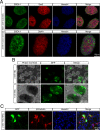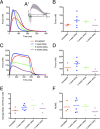Tumor prevention facilitates delayed transplant of stem cell-derived motoneurons
- PMID: 27606345
- PMCID: PMC4999595
- DOI: 10.1002/acn3.327
Tumor prevention facilitates delayed transplant of stem cell-derived motoneurons
Abstract
Objective: Nerve injuries resulting in prolonged periods of denervation result in poor recovery of motor function. We have previously shown that embryonic stem cell-derived motoneurons transplanted at the time of transection into a peripheral nerve can functionally reinnervate muscle. For clinical relevance, we now focused on delaying transplantation to assess reinnervation after prolonged denervation.
Methods: Embryonic stem cell-derived motoneurons were transplanted into the distal segments of transected tibial nerves in adult mice after prolonged denervation of 1-8 weeks. Twitch and tetanic forces were measured ex vivo 3 months posttransplantation. Tissue was harvested from the transplants for culture and immunohistochemical analysis.
Results: In this delayed reinnervation model, teratocarcinomas developed in about one half of transplants. A residual multipotent cell population (~ 6% of cells) was found despite neural differentiation. Exposure to the alkylating drug mitomycin C eliminated this multipotent population in vitro while preserving motoneurons. Treating neural differentiated stem cells prior to delayed transplantation prevented tumor formation and resulted in twitch and tetanic forces similar to those in animals transplanted acutely after denervation.
Interpretation: Despite a neural differentiation protocol, embryonic stem cell-derived motoneurons still carry a risk of tumorigenicity. Pretreating with an antimitotic agent leads to survival and functional muscle reinnervation if performed within 4 weeks of denervation in the mouse.
Figures




Similar articles
-
Reinnervation of adult rat gastrocnemius muscle by embryonic motoneurons transplanted into the axotomized tibial nerve.Exp Neurol. 1993 Dec;124(2):372-6. doi: 10.1006/exnr.1993.1208. Exp Neurol. 1993. PMID: 8287933
-
The immunophilin ligand FK506, but not the P38 kinase inhibitor SB203580, improves function of adult rat muscle reinnervated from transplants of embryonic neurons.Neuroscience. 2005;130(3):619-30. doi: 10.1016/j.neuroscience.2004.09.024. Neuroscience. 2005. PMID: 15590146
-
Reinnervation of the biceps brachii muscle following cotransplantation of fetal spinal cord and autologous peripheral nerve into the injured cervical spinal cord of the adult rat.Exp Neurol. 2001 Feb;167(2):329-40. doi: 10.1006/exnr.2000.7556. Exp Neurol. 2001. PMID: 11161621
-
The role of embryonic motoneuron transplants to restore the lost motor function of the injured spinal cord.Ann Anat. 2011 Jul;193(4):362-70. doi: 10.1016/j.aanat.2011.04.001. Epub 2011 Apr 30. Ann Anat. 2011. PMID: 21600746 Review.
-
Role of chronic Schwann cell denervation in poor functional recovery after nerve injuries and experimental strategies to combat it.Neurosurgery. 2009 Oct;65(4 Suppl):A105-14. doi: 10.1227/01.NEU.0000358537.30354.63. Neurosurgery. 2009. PMID: 19927054 Review.
Cited by
-
An optogenetic cell therapy to restore control of target muscles in an aggressive mouse model of amyotrophic lateral sclerosis.Elife. 2024 Jan 18;12:RP88250. doi: 10.7554/eLife.88250. Elife. 2024. PMID: 38236205 Free PMC article.
-
Microcircuit formation following transplantation of mouse embryonic stem cell-derived neurons in peripheral nerve.J Neurophysiol. 2017 Apr 1;117(4):1683-1689. doi: 10.1152/jn.00943.2016. Epub 2017 Feb 1. J Neurophysiol. 2017. PMID: 28148646 Free PMC article.
-
Intranasally applied human olfactory mucosa neural progenitor cells migrate to damaged brain regions.Future Sci OA. 2022 Jul 12;8(6):FSO806. doi: 10.2144/fsoa-2022-0012. eCollection 2022 Jul. Future Sci OA. 2022. PMID: 35909995 Free PMC article.
References
-
- Bromberg MB. Quality of life in amyotrophic lateral sclerosis. Phys Med Rehabil Clin N Am 2008;19:591–605. - PubMed
-
- Boakye M, Leigh BC, Skelly AC. Quality of life in persons with spinal cord injury: comparisons with other populations. J Neurosurg Spine 2012;17(1 Suppl):29–37. - PubMed
-
- Carlstedt T, Cullheim S. Spinal cord motoneuron maintenance, injury and repair. Prog Brain Res 2000;127:501–514. - PubMed
-
- Popovic D, Gordon T, Rafuse VF, Prochazka A. Properties of implanted electrodes for functional electrical stimulation. Ann Biomed Eng 1991;19:303–316. - PubMed
LinkOut - more resources
Full Text Sources
Other Literature Sources

